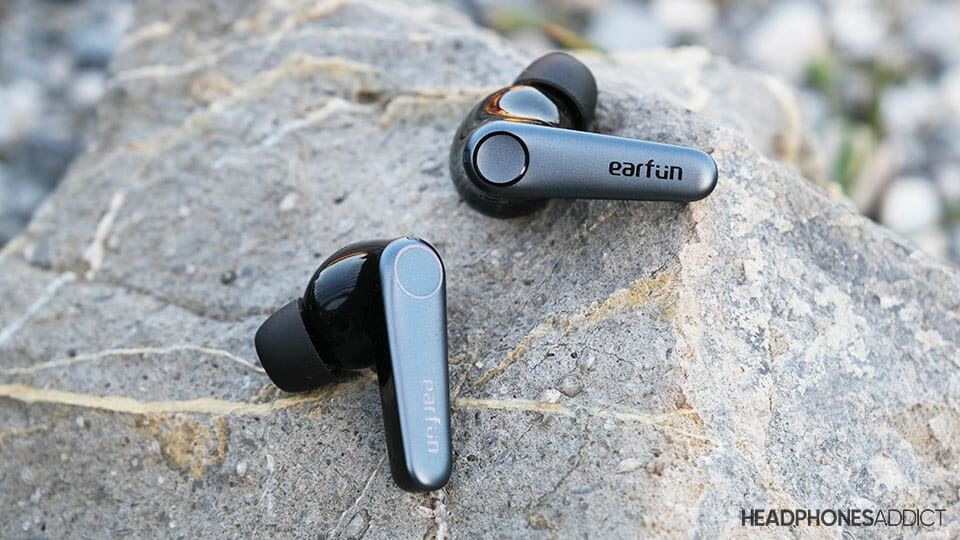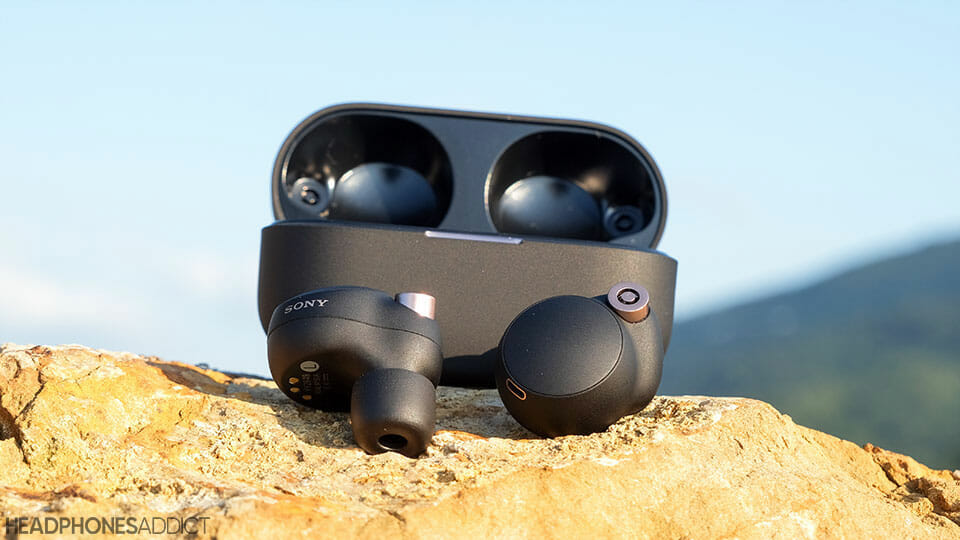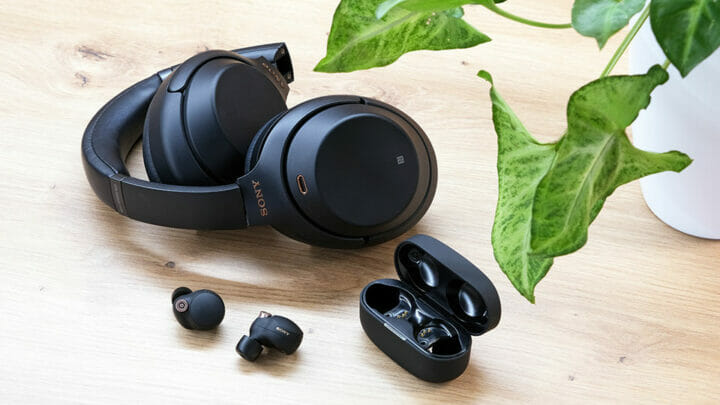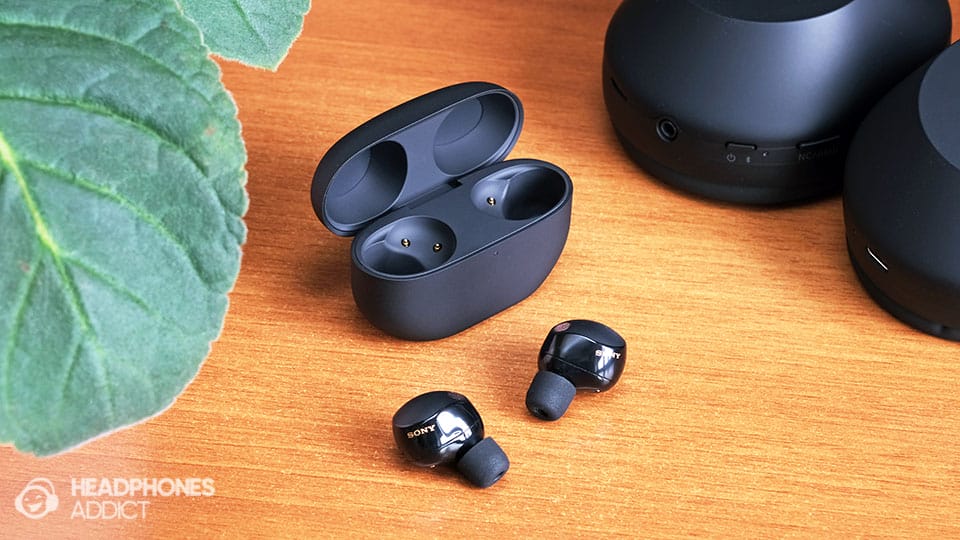
Sony WF-1000XM5 address many design issues that users had with their predecessor while improving sound enjoyment, comfort, and noise cancellation. However, they’re getting beaten in some areas by much cheaper alternatives.
As a daily driver of Sony WF-1000XM4, my expectations for Sony WF-1000XM5 are incredibly high. And for the most part, the new model delivers.
The Sony WF-1000XM5 sound fuller and more controlled in the bass. Active noise cancellation is also better than in the previous model, reducing lower frequencies by another 5dB.
Furthermore, the Sony Headphones app provides more features and options to connect your earbuds to music services and mobile games.
Comfort and stability have also increased immensely thanks to a smaller footprint and redesigned hybrid ear tips. Not to mention the passive noise isolation, which is outstandingly effective, from low to high frequencies.
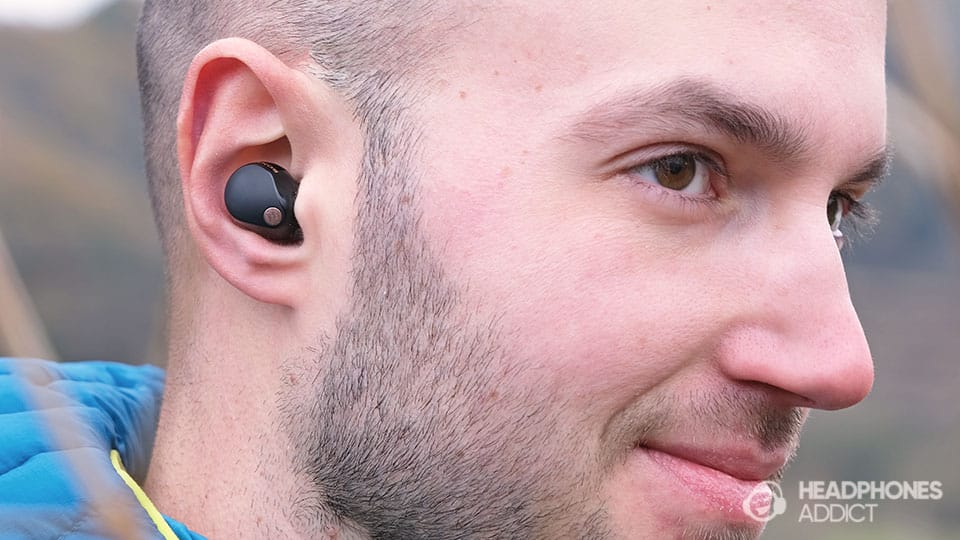
However, for some reason, the new ear tips appear more fragile, the call quality is shockingly bad, the ambient sound mode is less natural than before, and the app still refuses to fully customize touch controls.
Can you justify the price increase for the Sony WF-1000XM5? Are they worth buying if you already have WF-1000XM4? Find all the answers below.
Price:
Pros & Cons:
- Unmatched audiophile-grade sound quality
- Comfiest & most stable Sony earbuds to date
- Incredible passive noise isolation that even blocks rumble
- Negligible sound leakage at max volumes
- Good active noise cancellation…
- … but not even close of being class-leading
- Terrible call quality in noisier environments
- Protective mesh is built into ear tips, not into earbuds' nozzle
- Too many features wants your personal data
Category ratings:
Sound

Sony WF-1000XM5 maintain a similar level of detail retrieval from their predecessor while providing a fuller and more controlled bass response. Only the soundstage is slightly smaller.
Hear the difference: The Sony WF-1000XM5 – A/B sound test:
I enjoyed Sennheiser Momentum True Wireless 2 as the first true wireless earbuds to deliver IEM-like experience (clear, dynamic sound with wide soundstage).
However, it was Sony WF-1000XM4 when I was finally ready to fully switch to wireless technology. I’m happy that the new Sony WF-1000XM5 keep a similar sound signature and quality from their already fantastic predecessor.
However, while the bass has improved, the upper midrange hasn’t. Basically, while the new model sounds fantastic as well, they aren’t as neutral as the older one. More on that later.
Bass: Full, controlled, and with a decent oomph
The bass region has seen the most prominent improvements out of all regions. While earbuds have a similar bass response to the previous model, the new 8.4mm dynamic driver stays in control better.
Rumble is now more noticeable due to a slightly boosted sub-bass. Secondly, the driver can fully maintain the sound. That impacts vocals and instruments, especially bass guitars.
You get to hear nuances in the bass and experience music in a completely new light (if you have never listened to more premium headphones).
Furthermore, a larger driver (the XM4 model has a 6mm unit) produces slightly better oomph. The bass kick feels more impactful while retaining good control.
If you’re a metalhead, the earbuds can easily output tactile double-pedal drumming. Even bigger Sony WH-1000XM5 get all mushy during metal songs.
Sony WF-1000XM5 frequency response

- Learn how to read audio charts.
Midrange: Well-balanced after EQ, but a tad bright
Midrange sounds a bit recessed out of the box due to a dip between 2kHz and 4.5kHz.
Boosting the 2.5kHz frequency band in the custom EQ adds more energy to this region, making it sound more natural. However, while the instruments sound clearer, they remain a bit recessed. “You Give Love a Bad Name” by Bon Jovi could use slightly louder guitars, but that’s a minor complaint.
Overall, electric guitars sound as full-bodied and gritty as they should, which is good news for all the rockers out there.

Acoustic ones also produce a nice plucking sound; you hear each string vibrating under the player’s fingers.
One thing to mention is that the slight boost at the 5kHz makes the vocals ever so slightly bright. However, the coloration is minuscule and would only bother the most hardcore audio purists.
Nonetheless, the vocals sound lush and detailed. But the brighter tuning better suits male vocals rather than female ones.
Treble: Sparkly, energetic, and airy
Whereas treble response in the WF-1000XM4 can get tiresome due to excess energy, the Sony WF-1000XM5 do it with less excitement but an equal amount of detail.
Cymbals produce a lovely sparkle and are well-textured. You hear every cymbal hit and crush, which is excellent for listening to calmer genres like smooth jazz.
Moreover, there’s a good amount of air in the upper end of the frequency spectrum. That makes individual instruments and voices sound smoother and better separated.
Listen to in-app EQ presets in comparison to our custom EQ settings:
Another change from the previous model is the soundstage size. Sony WF-1000XM5 have a decent soundstage, still letting you feel like a sound is playing in a tiny room around your head.
However, the echo from clapping and guitar riffs in the “I Love Rock n’ Roll” from Joan Jett & the Blackhearts is less pronounced than in the XM4 model, with not as much depth.
Also, since the depth is greater than the width, the soundstage can feel a bit boxy and less three-dimensional.
On the flip side, earbuds do a great job accurately placing the sounds in the soundstage (imaging). There’s some blurriness in the center image, but nothing too concerning.
Does active noise cancelling change the frequency response?
Yes, active noise cancelling and ambient sound mode slightly change the frequency response. Enabling the two features reduces 400Hz and boosts 1.3kHz regions.
The reduction at 400Hz means vocals and instruments sound less full, while 1.3kHz makes those two things a bit louder.
Fortunately, the difference is minimal when listening to music and switching between modes. But if you find the difference too drastic, I made a custom EQ for ANC, so you should enjoy your earbuds regardless of your ANC mode.
Our custom EQ settings
For Sony WF-1000XM5, I made two custom EQ settings: one for when you use ANC and one for when you don’t.
Here are the settings for “ANC off” mode:
| Frequency band | Adjustment |
|---|---|
| 400Hz | -1 |
| 1kHz | 0 |
| 2.5kHz | +4 |
| 6.3kHz | 0 |
| 16kHz | +2 |
| Clear Bass | -2 |

And here is the setting for “ANC on” mode:
| Frequency band | Adjustment |
|---|---|
| 400Hz | +4 |
| 1kHz | -1 |
| 2.5kHz | +3 |
| 6.3kHz | 0 |
| 16kHz | +3 |
| Clear Bass | -2 |

Conclusion of the Sony WF-1000XM5’s sound.
Sony improved the new XM5 earbuds in bass and treble, making it slightly smoother. On the other hand, they recessed the guitars in the mids and made the soundstage smaller.
If you’re new to the premium audio market and want audiophile-grade sound in true wireless form, Sony WF-1000XM5 should definitely be on your list.
On the other hand, they aren’t worth upgrading from Sony WF-1000XM4. The latter still play incredibly well.
Comfort & Fit

Sony WF-1000XM5 are now much smaller and elegant, comfortably fitting in your ears and staying there even if you’re shaking your head like a lunatic.
The design of the Sony WF-1000XM5 and WF-1000XM4 is like a night and day. While some might say the previous model had “more character”, its comfort was highly polarizing.

Fortunately, the new version opts for a much smaller footprint. Bean-sized earbuds have a smooth surface that doesn’t press into your earlobes, avoiding pain.
New hybrid silicone/foam ear tips are less stiff since they use less foam, creating less pressure inside your ear canal. Their surface is rougher than in XM4, making them a bit scratchy if you twist them too much.

Speaking of ear tips, the rough surface is responsible for gripping your ear canals better. Earbuds hold to your ears like a champ, doing better than most earbuds for workout.
I was shaking my head like a madman and making exaggerated facial expressions to try and loosen the earbuds, but to no success.
Overall, these are the most stable and the comfiest earbuds from Sony to date. That said, some users still complain about the fit and use third-party ear tips instead, which can be problematic. More on that later.

Durability

Sony WF-1000XM5 are fully resistant to sweat and have an overall solid construction. However, the nozzle lacks a protective mesh, the foam on the tips is prone to tearing, and the charging case feels cheap.
Sony made several changes to build quality and ease of use in the new Sony WF-1000XM5.
Starting with the build, the earbuds are now made from 2 parts instead of 3 in the XM4 model. The protruding nozzle is also in a less awkward place. This means it’s less likely to accidentally break them.

Furthermore, the new hybrid ear tips are a bit slimmer since they use less foam. Thinner foam means you should be more careful not to pull on the tips too much.
I tore one ear tip while placing the earbuds into our MiniDSP measuring rig. While an average user won’t do that, it shows that the new tips are more fragile than in the XM4.
Another issue is the new nozzle since it lacks a protective mesh. The latter is incorporated into official hybrid ear tips, so you must use them to prevent ear wax from getting inside the earbuds and to obtain the IPX4 rating.

That’s why using third-party ear tips without protective mesh is problematic. That might also void the warranty in case of liquid damage.
As for the “ease of use”, unlike the XM4 earbuds, which were fully matte black, the new XM5 have a predominately glossy finish.
The latter works well with ear skin, as it minimizes friction and helps stability. However, in the case of Sony WF-1000XM5, it makes them slippery to pull out of the case.
Magnets holding the earbuds are strong, so it takes effort to pull them out. Some users report dropping them on the floor due to a slippery grip, so you need to be cautious.

Lastly, the charging case is the same height but noticeably slimmer than the XM4 one. However, it still uses similar thin-feeling plastic that makes it lightweight and cheap.
That said, the lid opens smoothly and closes with a crisp snap. However, compared to Apple AirPods Pro, it just doesn’t feel as satisfying or well-made.

Battery

In our test, the Sony WF-1000XM5 battery life lasts 5 hours and 47 minutes, much less than advertised. Fortunately, earbuds charge up pretty fast, and the case supports Qi wireless charging.
Sony WF-1000XM5 battery comparison

Sony WF-1000XM5 come with a promise of having battery life equally as long as their predecessor. However, our test shows a different picture.
In our battery test, we left the earbuds playing music at 50% volume and noise cancellation enabled. Here’s the result:
- 5 hours and 47 minutes of continuous playback on a single charge.
That is 2 hours and 13 minutes less than what Sony claims and 1.5 hours less than Sony WF-1000XM4. Turning off ANC extends the battery duration up to 12 hours, although you should realistically expect a few hours less.
The charging case holds an additional 16 hours of battery (or 2 additional charges). Although that is quite low, it at least supports Qi wireless charging and fast charging:
- You get an extra hour of listening time after just 3 minutes of charging.
Features

Sony WF-1000XM5 is packed with various features, some useful, some gimmicky, and some unnecessary. Sadly, the call quality is the worst of them, delivering bad results in noisy environments.
As expected, the Sony WF-1000XM5 don’t skim on features. Installing Sony’s Headphones app reveals the true scope of what you get with the earbuds:
- Adaptive Sound Control
- Bluetooth multipoint
- Ambient sound control
- Speak-to-Chat
- Equalizer
- Find Your Equalizer
- 360 Reality Audio
- DSEE Extreme
- Spatial Sound and Head Tracking
- Voice assistant
- Control customizer
- Head Gesture
- Voice capture during phone calls
- Notification & Voice Guide
- Services
Let’s cover all these features and see how they work and whether they’re helpful.
Adaptive Sound Control
Adaptive Sound Control is an advanced way of using active noise canceling and ambient sound mode.
Earbuds will automatically switch between different ANC modes depending on whether you’re sitting, walking, or taking a (bus) ride. In the app, you adjust what mode a specific action triggers.

Furthermore, depending on your GPS location, you can even select which ANC mode turns on/off. For example, you can select to automatically turn off ANC when entering the building where you work.
Downloading the Auto Play app extends this to music playback, as the app automatically pauses or resumes music depending on your actions. It even holds back notifications, so you don’t get bothered.
However, while some users might find these features helpful, you can do the same with a single tap on the earbud. There is no need to send your daily activities and location to Sony.
Speak-to-Chat
Speak-to-Chat feature pauses music playback and enables ambient sound mode when you start talking. The app lets you set the time it takes to resume the playback.

This feature, introduced in Sony WH-1000XM4, was gimmicky then and still is today.
It might be useful on a few occasions (like if you use earbuds in the office), but if you like to sing along while listening to music, it constantly pauses the playback, which gets annoying.
Equalizer
Customizable audio equalizer offers 5 frequency bands with +/-10(dB ?) increments. Those 5 frequencies are 400Hz, 1kHz, 2.5kHz, 6.3kHz, and 16kHz.
While pretty limited in its flexibility, it helps improve the default sound. You get some EQ presets, but they all work poorly.

Find Your Equalizer
You see the return of the “Find Your Equalizer” feature from the WH-1000XM5. While playing your music, it presents you with different numbered circles, each having a different tuning.
In 3 rounds, you pick different circles that later merge into a personalized EQ setting.

Sadly, the result isn’t as good as in the over-ear model, albeit the tuning is still slightly better than a default one.
360 Reality Audio
In this feature, you take images of your left and right ear, upon which the app calculates the 360 Audio settings that only work for you.

That said, to use 360 Audio, you also need one of the supported apps:
- 360 Reality Audio Live
- Artist Connection
- Nugs.net
- TIDAL (learn more about TIDAL’s music streaming statistics)
Based on our testing made with Sony WH-1000XM4, using 360 Audio degrades the audio quality. Also, most of the content now is from live performances.
Spatial Audio & Head Tracking
Based on previous experiences with Spatial Audio (including Apple’s version), it seems gimmicky.
It locks the audio in one place, changing direction based on your head movements. In my opinion, it negatively affects the listening experience without increasing immersive sensation, like when using Dolby Atmos, DTS Headphone:X, etc.
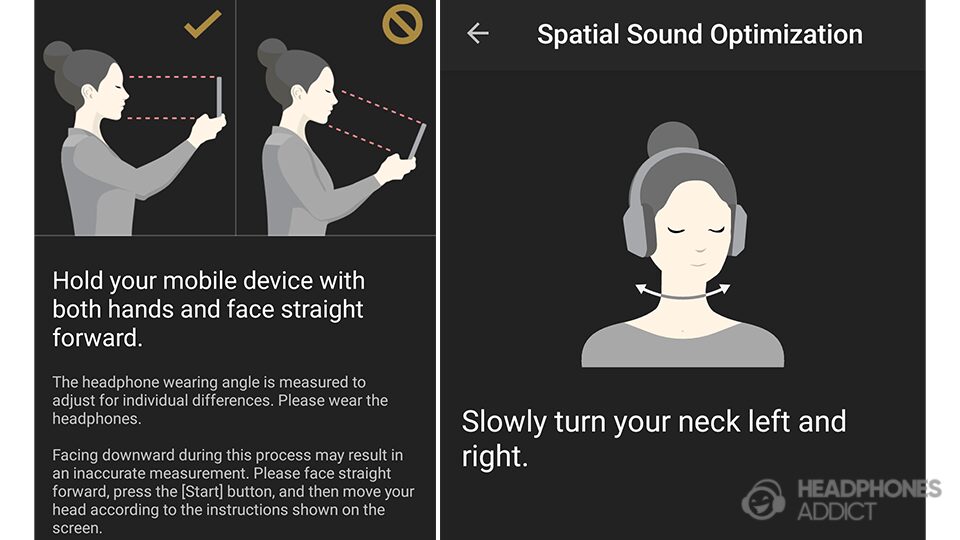
Unfortunately, I use a Samsung smartphone with Android 13’s Spatial Audio feature purposely locked to only work with Samsung earbuds. Therefore, I can’t test this feature.
Control customizer
Headphones app has a control customizer, but it is very rigid. Sure, it lets you customize touch controls, like switching ANC modes, using playback commands, or assigning “Quick Access” (opening Spotify or Endel app).
However, the customizer is still limited to command groups, meaning that only one side can change ANC modes, and the other can only control music playback. You can’t assign to play/pause on the left and to skip a song on the right.

That means that if you don’t assign Spotify Tap or Endel to the side with ANC modes, the double and triple-tap gestures are left empty.
To make things even more nonsensical, the WF-1000XM5 now support a quadruple-tap gesture, which acts as volume control. It’s unknown why Sony can’t make controls fully customizable.

Furthermore, Sony headphones and earbuds are notorious for suffering from “ghost touches” (when your warm breath activates a single-tap command).
Despite that, Sony didn’t include the option to disable single-tap commands, which would fix this issue.

Head Gesture
The Head Gesture feature uses accelerometers in the earbuds to perform a specific command:
- You accept the incoming call by nodding or reject it by shaking.
- You allow the Auto Play app to do its thing by nodding or turn it off by shaking.

Services
Services widget in the Headphones app enables you to link with apps like:
- Spotify Tap (gives you quick access to Spotify)
- Endel (relaxation app)
- Auto Play (an app that controls music playback and notifications depending on what you’re doing)
- Ingress Prime (a mobile game that uses augmented reality and Spatial Audio to boost immersion).

Speaking about Ingress Prime, the game is similar to Pokémon Go. It forces you to walk outside and capture portals.
However, adding earbuds, which dampen surrounding noise, next to the open-world game (which glues your eyes to a screen) sounds a bit dangerous.
Microphone quality
Sony WF-1000XM5 offer a decently clear call quality in a quiet environment but completely fail apart when exposed to loud environments.
Sony WF-1000XM5 microphone test: (no noise test from 0:00-0:32, with background noise test from O:32-0:59)
In a quiet room, the earbuds’ microphone does a decent job of keeping your voice clean. While you sound better compared to the Sony WF-1000XM4, you still appear a bit thin due to the lack of low frequencies.
Conversely, moving into a noisier area quickly drops the voice quality. Earbuds introduce distortion as they struggle to isolate your voice from the background noises.
When speaking next to a busy road, you start sounding like you’re possessed by a demon. In a word, the call quality on Sony WF-1000XM5 is embarrassing.

The app has a “Capture Voice During a Phone Call” toggle, which does what it says. That way, you hear yourself more naturally (speaking with your ears covered can sound strange to you).
It makes me sad that Sony has greenlit such a bad microphone performance. Especially since the over-ear Sony WH-1000XM5 made it in our best headphones with a microphone guide due to excellent call quality. Points taken away.
Noise Isolation

Sony WF-1000XM5 have impressive passive noise isolation, starting from the lowest frequencies and blocking a large chunk of higher ones. You can easily enjoy bus rides even without ANC.
I know foam ear tips are highly effective at passive noise isolation, but I still had to double-check the results from the Sony WF-1000XM5. That’s because their performance is by far the best we’ve seen during our tests.

Earbuds can block frequencies starting from 20Hz, which is insane. Sure, the reduction is initially small, but at 50Hz, you can already notice a difference. At 200Hz, earbuds already reduce noise by -15.2dB.
That’s surprising since most earbuds and headphones’ passive isolation becomes effective after passing 200Hz, with the best results after 1kHz.
Of course, the same thing applies here, where earbuds at 2kHz reduce around -30.6dB of noise, whereas at 4kHz, they already reduce it by a staggering -51.1dB.
Here’s a table of Sony WF-1000XM5’s passive noise isolation at blocking specific frequencies:
| Frequency | Noise reduction at that frequency |
|---|---|
| 100 Hz | -10dB |
| 200 Hz | -15.2dB |
| 400 Hz | -12.8dB |
| 600 Hz | -10.1dB |
| 1 kHz | -9.6dB |
| 2 kHz | -30.8dB |
| 4 kHz | -51.1dB |
| 6 kHz | -41.3dB |
| 10 kHz | -49.7dB |
| 15 kHz | -48.2dB |
Overall, you shouldn’t have issues drowning out other people in the office or on public transport, especially when listening to music. Of course, to block engine rumble, you still need ANC.
What about sound leakage?
Sound leakage is a non-issue with Sony WF-1000XM5. Even at dangerously high volumes, other people can’t hear what you’re listening to, even if you’re sitting in a quiet room.
Noise Cancelling

Sony WF-1000XM5 have better active noise cancelling performance than their predecessors but fail to beat or match some much cheaper competitors. The ambient sound mode could also sound fuller.
Sony WF-1000XM5 active noise cancelling test:
Sony noise-canceling headphones were once regarded as kings of noise reduction, sharing their throne with Bose. While that might be true for the Sony WH-1000XM5, the earbud division seemed to fall asleep.
To clarify, the active noise cancellation works really well at reducing sub-bass frequencies and most low and midrange ones. It makes a noticeable difference when isolating your music from outside noise.

However, tons of cheaper noise canceling earbuds manage to cancel out more external noise, like Google Pixel Buds Pro or even EarFun Air Pro 3, which cost less than $80.
Combined with a terrible microphone performance, we don’t know what’s happening with Sony and their noise cancelling algorithm.
Here’s the table with Sony WF-1000XM5 ANC test results:
| Frequency | Noise cancellation at that frequency (Sony WF-1000XM5) | Google Pixel Buds Pro | EarFun Air Pro 3 |
|---|---|---|---|
| 30 Hz | -23.7dB | -11.4dB | -16.3dB |
| 50 Hz | -24.5dB | -18.6dB | -20.2dB |
| 70 Hz | -21dB | -27dB | -30.1dB |
| 90 Hz | -30.3dB | -31.2dB | -30.9dB |
| 200 Hz | -32.9dB | -45.2dB | -44.2dB |
| 400 Hz | -21.6dB | -36.9dB | -35.9dB |
| 600 Hz | -12.4dB | -17dB | -21.3dB |
| 800 Hz | -7.6dB | -13.3dB | -21.5dB |
| 1 kHz | -6.4dB | -6.1dB | -13.3dB |
| 2 kHz | -23.7dB | -15.3dB | -16.8dB |
What about ambient sound mode?
The ambient sound mode performance resembles the XM4 model but has a slightly thinner voice pickup. It still works well when you want to avoid putting the earbuds out when speaking to someone.

However, like with ANC, some cheaper earbuds manage to pick up ambient sound more naturally and with an extended frequency response.
In case you want to hear a little of your surroundings, the app allows you to adjust ambient sound mode intensity from 1 to 20.
Bluetooth

Sony WF-1000XM5 have a decent indoor range of 35 feet, an LDAC support, and Bluetooth multipoint. Their gaming lag is also minimal and good enough for non-demanding gamers.
Using Bluetooth 5.3, the Sony WF-1000XM5 maintain a stable connection. So far, I haven’t experienced any audio stutters.
However, using Bluetooth version 5.3 doesn’t guarantee long connection ranges. In our indoor Bluetooth range test, we got:
- 35 feet (or 10.6 meters) of indoor Bluetooth connection range until the audio completely stops.
Unlike in Sony WH-1000XM5, prioritizing connection over sound quality doesn’t extend the range. At least not noticeably, meaning that the antennas in the earbuds are fairly weak.
How to pair Sony WF-1000XM5?
- Opening the charging case for the first time, the earbuds immediately jump into pairing mode. On Android phones, you should see the Google Fast Pair pop-up message, letting you connect the earbuds to your Google account.
- To pair the earbuds to another device, place them in the case and hold the button on the back until a tiny LED light starts slowly blinking. That’s when you know you’re in a pairing mode.

Sony WF-1000XM5 also support Bluetooth multipoint, letting you connect them to 2 different devices simultaneously. In the Sony Headphones Connect app, you can see to which devices your earbuds are connected.
Using multipoint, the earbuds will automatically switch audio sources depending on which device last emitted the sound. If you receive a call, it also automatically switches from your laptop to a smartphone.
Here’s how you enable multipoint on Sony WF-1000XM5:
- In the Sony’s Headphones app, tap the “System” widget and enable “Connect to 2 devices simultaneously”.

- Then, pair your earbuds to two devices using the steps above.
- Once at least 2 devices “know” your earbuds, connect them to both devices separately.
- In the “Status” widget in the app, you can observe the “Connected device(s)”, manually switch between them, or even force your earbuds to disconnect from a specific device.

What Bluetooth codecs do they use?
Sony WF-1000XM5 use SBC, AAC, a high-quality LDAC, and the new LC3 Bluetooth codec, which is a part of Bluetooth version 5.2 and above.
Without connection interference, the LDAC gives you a high bitrate of 990kbps. However, you still have a hard time telling the difference between LDAC and a normal AAC.
Is there an audio lag?
There’s zero audio lag when watching video content on your smartphone or a Windows laptop.
On the other hand, there’s a visible delay when playing games on mobile. Fortunately, the latency is small, so you should comfortably play any game you want unless you’re a competitive gamer.
Should You Get Sony WF-1000XM5?

Sony WF-1000XM5 are without the doubt the best-sounding true wireless earbuds on the market. They’re also improved in many areas compared to the Sony WF-1000XM4.
However, Sony could’ve done more to justify their increase in price compared to the XM4 model by further improving noise cancellation and ambient sound mode. They’re great but not as class-leading as their marketing makes you believe.

That’s the opposite of what you want when buying high-end Bluetooth earbuds. As it stands, we can recommend Sony WF-1000XM5 to:
- Audiophiles who want the highest sound quality you can possibly get from wireless earbuds.
- Commuters and travelers that want long-lasting comfort, good battery life, and good active noise cancellation.
- Gym-goers or even runners that will use official ear tips.
On the other hand, we can’t recommend these earbuds to:
- Frequent phone and video callers, as the call quality is truly underwhelming.
- Clumsy people who might frequently drop the earbuds on the floor due to their slippery exterior.
While still providing better sound quality than most, Sony needs to realize that the WF-1000XM5 are getting beaten by much cheaper alternatives in areas like ANC, ambient sound mode, call quality, and feature customizability and usefulness.
Hopefully, they address these drawbacks in future updates.
The latest deals:
How do Sony WF-1000XM5 compare to the competition?
- Sony WF-1000XM5 have a higher-quality sound than competitors, offering audiophile-grade performance.
- They are one of the most comfortable and stable earbuds, beating even people’s favorite AirPods Pro.
- Headphones app offers an overwhelming number of features compared to the competition.
- Despite having a lot of features, only some are useful, and most are barely customizable, whereas competitors have fewer but more customizable features.
- Earbuds have an overall average battery life of almost 6 hours per charge, whereas competition typically lasts for more than 7 hours (with ANC activated).
- Their call quality in noisier environments is the worst compared to all Bluetooth earbuds we’ve tested.
Sony WF-1000XM5 alternatives
EarFun Air Pro 3
They cost less than $80 and don’t sound and stay stable in your ears nearly as good. However, their noise cancellation is miles better than Sony’s. Furthermore, they boast over 8 hours of battery life per charge, have a more natural-sounding ambient sound mode, and an IPX5 rating.
Sony WF-1000XM4
While the bass sometimes feels a bit slow, they sound more natural in the midrange. Their ambient sound mode is also slightly clearer in comparison.
Comfort and ANC are slightly worse, and you get to play with fewer features than the XM5 model. However, the battery life stays similar, and you can get them at a much lower price (although Sony might discontinue them due to battery issues).
EarFun Free Pro 3
At $80, the Free Pro 3 offers exceptional sound quality that doesn’t quite match the refinement of the Sony, but it is still pretty close.
Furthermore, earbuds offer excellent comfort, more natural ambient sound mode, and better feature customizability. But, you get a slightly worse noise canceling performance, stability, and battery life of only 5 hours.
What’s in the Box?

- Sony WF-1000XM5 true wireless earbuds
- Charging case
- USB-C to USB-A charging cable
- 4 pairs of hybrid ear tips (XS, S, M, L)
- User guide
- A free trial code for 360 Reality Audio
Specifications
| Type: | True wireless |
| Connection: | Bluetooth 5.3 |
| Back design: | Closed-back |
| Drivers: | 8.4mm dynamic |
| Frequency range: | 20-20.000Hz (with AAC), 20-40.000Hz (with LDAC) |
| Impedance: | n/a |
| Weight: | 0.21 ounces (or 5.9 grams) per earbud |
| Mic & Controls: | Yes |
| Water resistance: | IPX4 |
| Battery life: | 6h + 16h in case (with ANC) |
| Charging time: | 1.5h – quick charge – USB-C & Qi wireless |
| Active noise cancelling: | Yes, hybrid |
| Bluetooth codecs: | SBC, AAC, LDAC, LC3 |
| Wireless range: | 35 feet (10.6 meters) |
| Microphone: | 6 mics in total, with two NC processors |

From a childhood fascination with sound, Peter’s passion has evolved into a relentless pursuit of the finest headphones. He’s an audio expert with over 5 years of experience in testing both audiophile and consumer-grade headphones. Quote: “After many years, I can confidently tell which headphones are good and which are terrible.” Find his honest opinion in his reviews.







